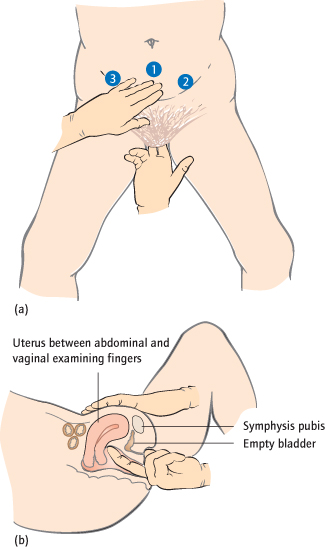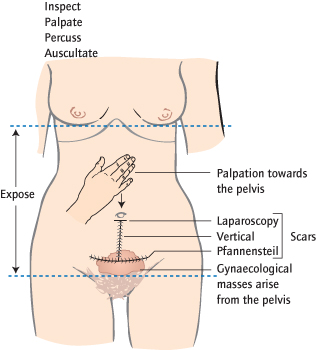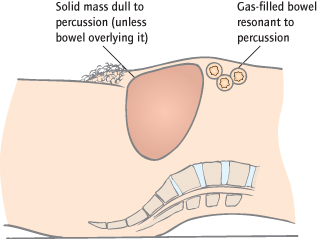Abdominal Examination
The patient lies comfortably on her back with her head on a pillow, discreetly exposed from the xiphisternum to the symphysis pubis. The bladder should be empty.
Inspect
Look for scars, particularly just above the symphysis pubis and in the umbilicus. Look at the distribution of body hair, for irregularities, striae and hernias.
Palpate
Ask about tenderness first, then palpate gently around the abdomen looking for masses or tenderness. Then palpate specifically for masses from above the umbilicus down to the symphysis pubis (Fig. 1.2). If any masses are present, do they arise from the pelvis (i.e. can you get below them)?
Percuss
Go around the abdomen. The bowel is resonant; fluid-filled and solid cavities (e.g. masses, full bladder) are dull (Fig. 1.3). Look for shifting dullness (free fluid).
Auscultate
Listen to the bowel sounds.
Gynaecological Examination
General
(Breast)
Abdomen
Pelvic palpation: digital
Cervical/vaginal inspection: speculum
Vaginal Examination
Ensure privacy, explain simply what you intend and ask for the patient’s permission. Offer her the opportunity to use the bathroom first. A chaperone must be offered, whether you are male or female, and the presence and name of the chaperone documented in the notes. Use lubricating jelly. A metal speculum should be warmed. Internal examination is often uncomfortable, but severe tenderness is abnormal.
Inspect
The vulva and the vaginal orifice are inspected first. Are there any coloured areas, ulcers or lumps on the vulva? Is a prolapse evident at the introitus? Three types of examination have different purposes.
Digital Bimanual Examination
This assesses the pelvic organs. The patient lies flat, with her ankles together drawn up towards her buttocks and knees apart. Warn the patient before you touch her and ask her to let you know if she finds the examination too uncomfortable. The left hand is placed on the abdomen above the symphysis pubis and is pushed down into the pelvis, so that the organs are palpated between it and two fingers are gently inserted into the vagina (Fig. 1.4a,b).
Fig. 1.4 Digital bimanual vaginal examination: (a) bimanually palpate areas 1, 2, 3 in order; (b) digital bimanual palpation of the pelvis.

Stay updated, free articles. Join our Telegram channel

Full access? Get Clinical Tree




